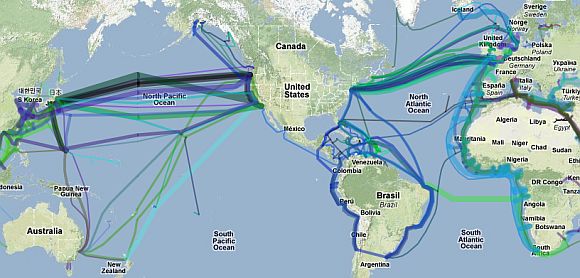 In describing the internet, people often talk of “the cloud.” We connect through over an ethernet, where ether is an archaic term from the Latin aethēr meaning “the upper pure, bright air.” But as they say in Brooklyn, fuhgeddaboutit! Most of the internet is beneath the sea carried by submarine communications cables. By some accounts, the cables carry 95 percent of daily communications. Now there are serious concerns in the US military and intelligence that Russian submarines and spy ships are aggressively operating near the vital undersea cables that carry almost all global Internet communications. If the Russians, or anyone else, should attack the cables, they could potentially shut potentially shut down large sections of the Internet.
In describing the internet, people often talk of “the cloud.” We connect through over an ethernet, where ether is an archaic term from the Latin aethēr meaning “the upper pure, bright air.” But as they say in Brooklyn, fuhgeddaboutit! Most of the internet is beneath the sea carried by submarine communications cables. By some accounts, the cables carry 95 percent of daily communications. Now there are serious concerns in the US military and intelligence that Russian submarines and spy ships are aggressively operating near the vital undersea cables that carry almost all global Internet communications. If the Russians, or anyone else, should attack the cables, they could potentially shut potentially shut down large sections of the Internet.
While there has been lots of scary talk about lasers taking out satellites and electromagnetic pulse weapons frying all electronics, the only thing the Russians need to take out a submarine cable is a large cable cutter. The underwater cables are also surprisingly vulnerable. As reported in Wired:
“We usually think of the internet as distributed,” Nicole Starosielski, a media scholar at New York University, says. Because of the built-in redundancies, an attack at a given point in the terrestrial network is unlikely to bring the whole thing down. Not so under the sea. “I think people would be surprised to know that there are a little over 200 systems that carry all of the internet traffic across the ocean, and these are by and large concentrated in very few areas. The cables end up getting funneled through these narrow pressure points all around the globe.”
Stephen Colbert recently looked at the problem of what Americans might do if submarine cables were cut or disrupted. He assembles an “Internet disruption go bag.”

Super interesting read, I love this stuff. Here’s a fun animation that shows how we lay undersea cable: https://commons.wikimedia.org/wiki/File:Undersea_cable_laying.ogv
While it’s certainly true that much of the internet is reliant upon undersea cables the redundant nature of these paths is astounding in its complexity. You could lose all the cables across an ocean and still traffic would flow from any continent to any other continent.
Imagine California communicating with Japan and we suddenly lose every cable in the Pacific. Routes are reconfigured automatically by protocols like spanning tree protocol and traffic simply routes the other way: across the US, across the Atlantic, across Europe, across Asia or Africa, and to Japan.
There may be bandwidth issues but not total disconnection across the globe. We’d be okay.
I’m willing to bet there are some dark fibers across the oceans too (fiber cables that aren’t currently in use, hence “dark”) that the general public and hopefully Russia don’t know about. Bouncing microwaves off a satellite is another way to get more data across the planet, though I have no idea what kind of bandwidth that affords us. In short, I don’t think we’ll see a unilateral act of sabotage disconnect continents from the internet.
Last year Russia was getting close to some cables up in the Netherland and they were worried that Russia would cut the cables.
Not just internet, voice goes over them too.
Here is a better map, you can drag it around:
Submarine Cable Map
The Submarine Cable Map is a free resource from TeleGeography. Data contained in this map is drawn from the Global Bandwidth Research Service and is updated on a regular basis.
http://www.submarinecablemap.com/
US Navy has been doing stuff like this for years with out cutting any cables. Read Blind Man’s Bluff by Sontag and Drew.
For a quick preview of Operation Ivy Bells – https://en.wikipedia.org/wiki/Operation_Ivy_Bells
Want to know why we hated Pelton, this should explain it…